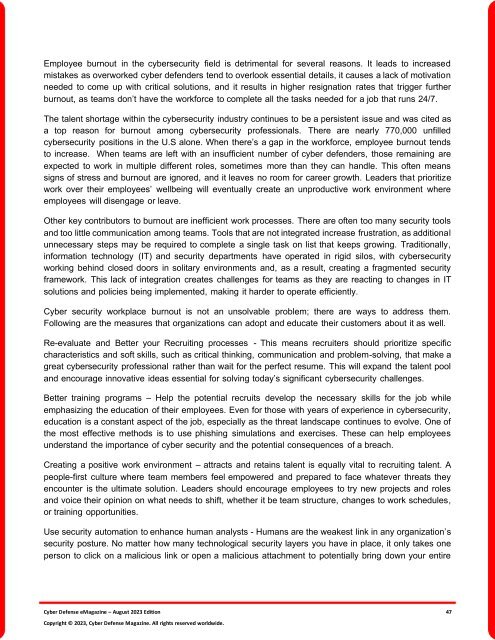The Cyber Defense eMagazine August Edition for 2023
Cyber Defense eMagazine August Edition for 2023 #CDM #CYBERDEFENSEMAG @CyberDefenseMag by @Miliefsky a world-renowned cyber security expert and the Publisher of Cyber Defense Magazine as part of the Cyber Defense Media Group as well as Yan Ross, Editor-in-Chief and many more writers, partners and supporters who make this an awesome publication! Thank you all and to our readers! OSINT ROCKS! #CDM #CDMG #OSINT #CYBERSECURITY #INFOSEC #BEST #PRACTICES #TIPS #TECHNIQUES
Cyber Defense eMagazine August Edition for 2023 #CDM #CYBERDEFENSEMAG @CyberDefenseMag by @Miliefsky a world-renowned cyber security expert and the Publisher of Cyber Defense Magazine as part of the Cyber Defense Media Group as well as Yan Ross, Editor-in-Chief and many more writers, partners and supporters who make this an awesome publication! Thank you all and to our readers! OSINT ROCKS! #CDM #CDMG #OSINT #CYBERSECURITY #INFOSEC #BEST #PRACTICES #TIPS #TECHNIQUES
You also want an ePaper? Increase the reach of your titles
YUMPU automatically turns print PDFs into web optimized ePapers that Google loves.
Employee burnout in the cybersecurity field is detrimental <strong>for</strong> several reasons. It leads to increased<br />
mistakes as overworked cyber defenders tend to overlook essential details, it causes a lack of motivation<br />
needed to come up with critical solutions, and it results in higher resignation rates that trigger further<br />
burnout, as teams don’t have the work<strong>for</strong>ce to complete all the tasks needed <strong>for</strong> a job that runs 24/7.<br />
<strong>The</strong> talent shortage within the cybersecurity industry continues to be a persistent issue and was cited as<br />
a top reason <strong>for</strong> burnout among cybersecurity professionals. <strong>The</strong>re are nearly 770,000 unfilled<br />
cybersecurity positions in the U.S alone. When there’s a gap in the work<strong>for</strong>ce, employee burnout tends<br />
to increase. When teams are left with an insufficient number of cyber defenders, those remaining are<br />
expected to work in multiple different roles, sometimes more than they can handle. This often means<br />
signs of stress and burnout are ignored, and it leaves no room <strong>for</strong> career growth. Leaders that prioritize<br />
work over their employees’ wellbeing will eventually create an unproductive work environment where<br />
employees will disengage or leave.<br />
Other key contributors to burnout are inefficient work processes. <strong>The</strong>re are often too many security tools<br />
and too little communication among teams. Tools that are not integrated increase frustration, as additional<br />
unnecessary steps may be required to complete a single task on list that keeps growing. Traditionally,<br />
in<strong>for</strong>mation technology (IT) and security departments have operated in rigid silos, with cybersecurity<br />
working behind closed doors in solitary environments and, as a result, creating a fragmented security<br />
framework. This lack of integration creates challenges <strong>for</strong> teams as they are reacting to changes in IT<br />
solutions and policies being implemented, making it harder to operate efficiently.<br />
<strong>Cyber</strong> security workplace burnout is not an unsolvable problem; there are ways to address them.<br />
Following are the measures that organizations can adopt and educate their customers about it as well.<br />
Re-evaluate and Better your Recruiting processes - This means recruiters should prioritize specific<br />
characteristics and soft skills, such as critical thinking, communication and problem-solving, that make a<br />
great cybersecurity professional rather than wait <strong>for</strong> the perfect resume. This will expand the talent pool<br />
and encourage innovative ideas essential <strong>for</strong> solving today’s significant cybersecurity challenges.<br />
Better training programs – Help the potential recruits develop the necessary skills <strong>for</strong> the job while<br />
emphasizing the education of their employees. Even <strong>for</strong> those with years of experience in cybersecurity,<br />
education is a constant aspect of the job, especially as the threat landscape continues to evolve. One of<br />
the most effective methods is to use phishing simulations and exercises. <strong>The</strong>se can help employees<br />
understand the importance of cyber security and the potential consequences of a breach.<br />
Creating a positive work environment – attracts and retains talent is equally vital to recruiting talent. A<br />
people-first culture where team members feel empowered and prepared to face whatever threats they<br />
encounter is the ultimate solution. Leaders should encourage employees to try new projects and roles<br />
and voice their opinion on what needs to shift, whether it be team structure, changes to work schedules,<br />
or training opportunities.<br />
Use security automation to enhance human analysts - Humans are the weakest link in any organization’s<br />
security posture. No matter how many technological security layers you have in place, it only takes one<br />
person to click on a malicious link or open a malicious attachment to potentially bring down your entire<br />
<strong>Cyber</strong> <strong>Defense</strong> <strong>eMagazine</strong> – <strong>August</strong> <strong>2023</strong> <strong>Edition</strong> 47<br />
Copyright © <strong>2023</strong>, <strong>Cyber</strong> <strong>Defense</strong> Magazine. All rights reserved worldwide.

















